
Olearia axillaris, commonly known as coastal daisy-bush, coast daisy-bush or coastal daisybush is a species of flowering plant in the family Asteraceae and is endemic to coastal areas of Australia. It is an erect, bushy shrub with densely cottony-hairy branchlets, aromatic, linear to narrowly elliptic or narrowly lance-shaped to egg-shaped leaves with the narrower end towards the base and small white and yellow, daisy-like inflorescences.

Olearia pimeleoides, commonly known as pimelea daisy-bush, is a species of flowering plant in the family Asteraceae and is endemic to southern continental Australia. It is an erect shrub with elliptic, linear or lance-shaped leaves, and white and pale yellow, daisy-like inflorescences.
Minuria is a genus of annuals, perennials and dwarf shrubs in the tribe Astereae within the familyAsteraceae.
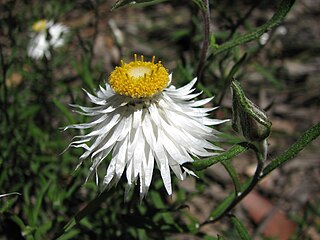
Helichrysum leucopsideum, commonly known as satin everlasting, is a flowering, perennial herb in the family Asteraceae. It is grows in all states of Australia except Queensland and the Northern Territory. It has white, terminal flower heads and narrow, woolly leaves.

Ozothamnus rufescens is an Australian shrub in the family Asteraceae, native to the states of New South Wales and Queensland. Usually seen on the edges of rainforests, up to 4 metres in height. The southernmost point of its natural distribution is near Muswellbrook, New South Wales.
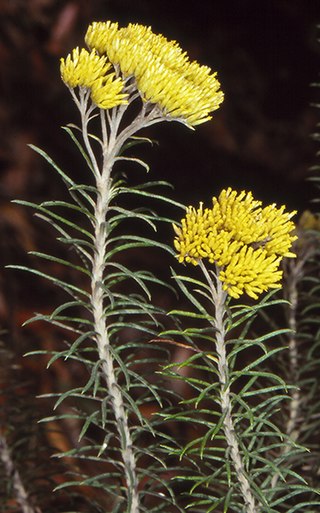
Cassinia cunninghamii, commonly known as Cunninghams everlasting, is a plant native to central New South Wales in eastern Australia.
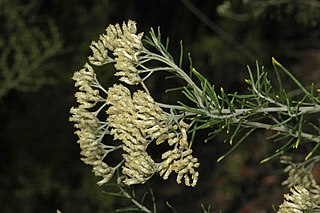
Cassinia uncata, commonly known as sticky cassinia, is a species of flowering plant in the family Asteraceae and is native to inland New South Wales and the south-east of South Australia. It is an erect shrub with hairy young stems, narrow linear to needle-shaped leaves, and heads of off-white to cream-coloured flowers arranged in rounded, almost conical panicles.

Persoonia trinervis is a species of flowering plant in the family Proteaceae and is endemic to the south-west of Western Australia. It is an erect, sometimes spreading shrub with densely hairy young branchlets, spatula-shaped or lance-shaped leaves with the narrower end towards the base, and densely hairy yellow flowers.
Persoonia hakeiformis is a species of flowering plant in the family Proteaceae and is endemic to the south-west of Western Australia. It is an erect or spreading to low-lying shrub with mostly smooth bark, linear leaves and bright yellow flowers borne in groups of up to sixty along a rachis up to 100 mm (3.9 in) long.
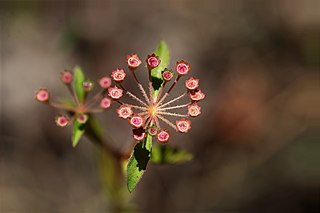
Pomax is a genus of flowering plants in the coffee family, Rubiaceae. Pomax umbellata, found in Australia, is the sole species of the genus. The genus was created in 1830, by the Swiss taxonomist Augustin Pyramus de Candolle, and published in his Prodromus Systematis Naturalis Regni Vegetabilis. Pomax umbellata was first described as Opercularia umbellata by Joseph Gaertner in 1788. but was transferred to the genus, Pomax by Daniel Solander in 1834.

Scaevola glandulifera, the viscid hand-flower, is a shrub in the family Goodeniaceae, endemic to Western Australia.
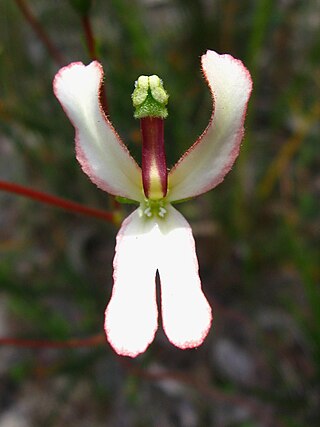
Stylidium schoenoides is a species of dicotyledon plant of the Stylidium genus, from Stylidiaceae family, Asterales order, first described by Augustin Pyramus de Candolle in 1839. The plant is endemic to Western Australia.

Tremandra stelligera is a flowering plant in the family Elaeocarpaceae. It is a small upright shrub with pink, purple or blue flowers, dark green oval shaped leaves and is endemic to Western Australia.
Tremandra diffusa is a species of flowering plant in the family Elaeocarpaceae. It is a small shrub with white flowers and green oval shaped leaves.
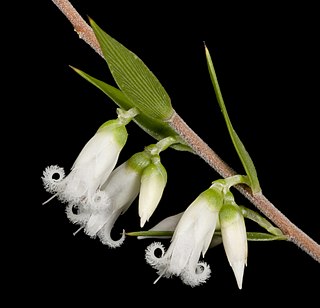
Styphelia conostephioides is a plant in the family Ericaceae native to Western Australia. It was first described in 1839 as Leucopogon conostephioides by Augustin Pyramus de Candolle. In 1867 Ferdinand von Mueller transferred it to the genus, Styphelia, but the accepted name continued to be Leucopogon conostephioides. However in 2020, with a publication concerning the phylogeny of Styphelia by Crayn and others, the name Styphelia conostephioides was accepted by the Herbarium of Western Australia.
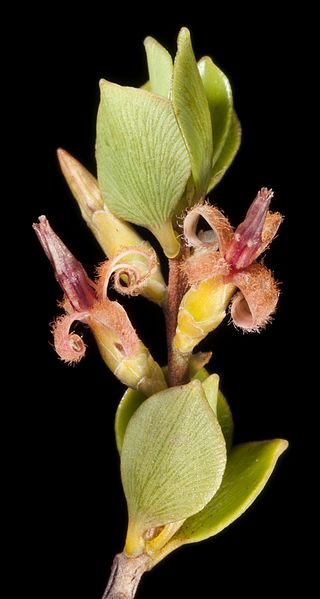
Styphelia coelophylla is a plant in the family Ericaceae native to Western Australia. It was first described as Leucopogon coelophyllus in 1839 by Allan Cunningham, but based on the phylogenetic studies of Darren Crayn, Michael Hislop and Caroline Puente-Lelièvre in 2020 it was moved to the genus, Styphelia, and Styphelia coelophylla is the name accepted by the WA herbarium.
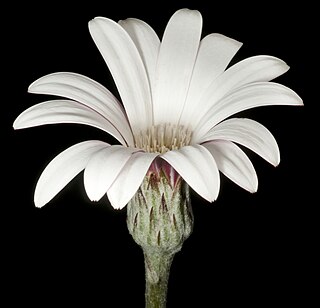
Trichocline spathulata, common name native gerberam is a plant in the family Asteraceae, found in the south-west of Western Australia.

Chrysocephalum baxteri, known by the common name fringed everlasting is a perennial herb native to southern Australia. It is a member of the Asteraceae, the daisy family. Found in low heath country and sclerophyll forest. A small plant, 10 to 40 cm high with many stems. Leaves are linear in shape, 4 to 30 mm long, 0.5 to 2.5 mm wide. Both leaf surfaces are a felty grey/green. White flowers mostly form in spring and summer.
Olearia elaeophila is a species of flowering plant in the family Asteraceae and is endemic to the south-west of Western Australia. It is a small shrub with scattered linear leaves, and white or blue and yellow, daisy-like inflorescences.

Olearia ramosissima, commonly known as much-branched daisy bush, is a species of flowering plant in the family Asteraceae and is endemic to continental Australia. It is a straggly shrub with densely-crowded, elliptic, egg-shaped or triangular leaves, and blue to violet and blue or yellow, daisy-like inflorescences.

















